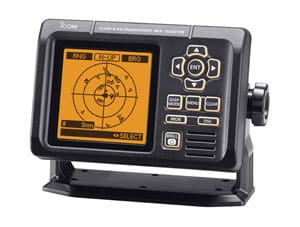The current overlap of radar and automatic identification system (AIS) technology leaves sailors on small oceangoing craft in a quandary: Which is the more sensible system in terms of initial cash outlay, amperage use and overall service in ensuring safety and security?
Just as Loran-C and radio direction finders were long ago relegated to the forgotten graveyards of maritime detritus, so too has the short-lived CARD (collision avoidance radar detector) system given way to contemporary AIS technology. However, even with the convenience of AIS, radar is still regarded as the standard for dependable vessel tracking capability and collision avoidance. On the downside, radar uses significantly more amperage than the receive-only AIS systems currently available, which on a large yacht is still a negligible amount easily covered by a combination of the engine alternator and a generator set. AIS offers some — not all — of the advantages of radar at a fraction of the price, yet with much lower power consumption. Large yachts generally employ both radar and AIS in tandem for maximum protection.
On small coastal and offshore cruising craft, where every amp-hour of battery charge counts, power consumption can be a decisive factor in whether to install radar, AIS or both. A typical radar array, such as the Garmin GMR 18 xHD, consumes 3 amps and a modest chartplotter like the Garmin 7000-series GPSMAP consumes an extra amp for a total of 4 amps, or 96 amp-hours per day — more than half the total capacity of an 8D dual-purpose, flooded deep-cycle battery. Few sailing vessels under 50 feet LOA can afford such an extravagance 24 hours a day.
On the other hand, the Garmin VHF 300 AIS radio uses roughly one-third of an amp on standby, equating to a negligible 8 amp-hours per day. The integrated AIS receiver allows you to identify oceangoing cargo vessels, assuming they are also AIS-equipped. The ICOM MA-500TR AIS transceiver functions as a transponder, automatically notifying other vessels of your position. Its screen, similar to that of a radar, provides a simple dot-matrix visual display of other vessels in your area. The unit consume 1.5 amps on transmit and 0.7 amps on receive.
Of course, on a crossing from Christmas Island to Réunion in the southern Indian Ocean, there is no guarantee that large commercial vessels will be AIS compliant. By the same token, there is no guarantee they will bother to monitor the VHF radio. But we can safely assume that most commercial vessels on ocean crossings will have AIS and radar running around the clock, and also will have a radio operator on duty at all times. Even if you cannot see them, they can see you. An 800-foot containership has a lot at stake, so a few thousand dollars’ worth of electronic communications equipment is cheap insurance.
On a cruising yacht sailing well offshore and outside of shipping lanes, the chances of collision with another vessel are almost nil. However, there is always that minute chance, and AIS offers the necessary protection from large commercial vessels. Near land, particularly in dense fog with heavy shipping traffic, those chances are much greater, especially if we factor in the presence of small pleasure craft. Probably fewer than half of all U.S. recreational coastal vessels use AIS or radar.
To sum up, the best collision-avoidance strategy depends on where you sail. If you intend to limit your travels to within 100 miles of shore and your area is prone to fog, such as the California coast, radar makes plenty of sense. On the other hand, if you aim to undertake long ocean passages, spending most of your time in the tropics and closely watching your daily amperage use, then AIS is in some ways the better choice.
Circumnavigator/author Bill Morris believes the best strategy for succeeding as an offshore voyager is to keep systems simple and, if possible, manual. Key to survival are a basic array of electronics and an aggressive alternative energy matrix to ensure maximum charge and longevity in the ship’s battery banks. Bill’s new book, Sun, Wind, and Water: The Essential Guide to the Energy-Efficient Cruising Boat, is due to be published by Seaworthy Publications in spring 2016.

